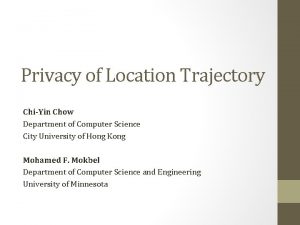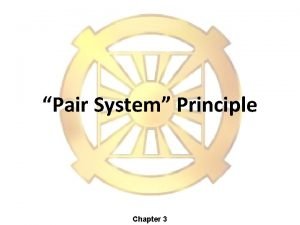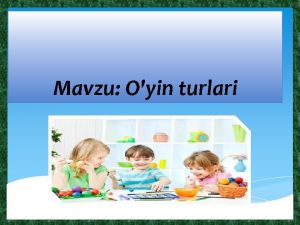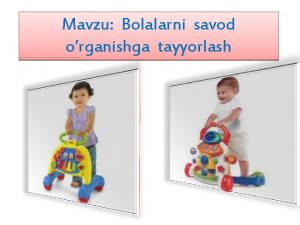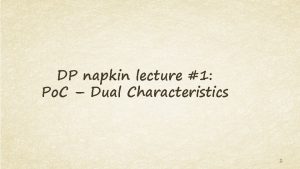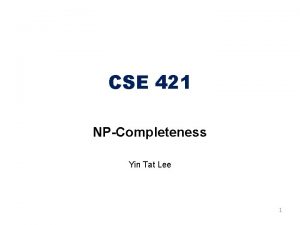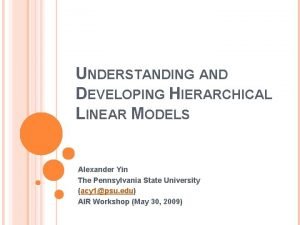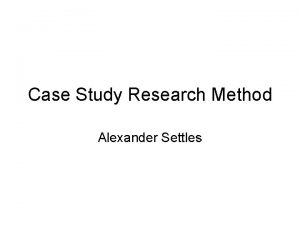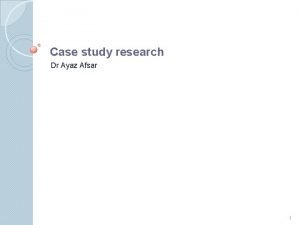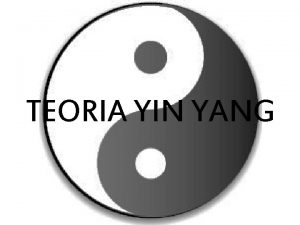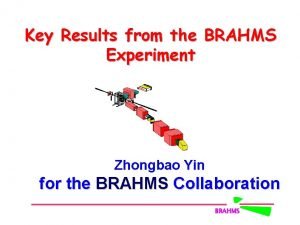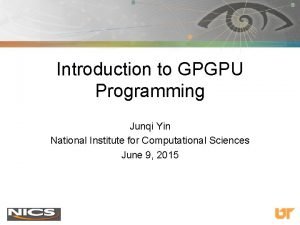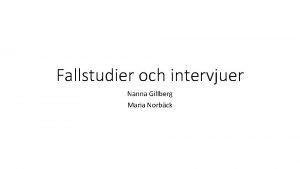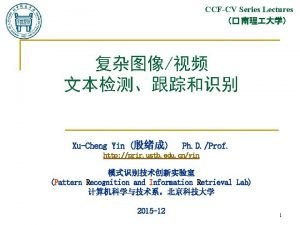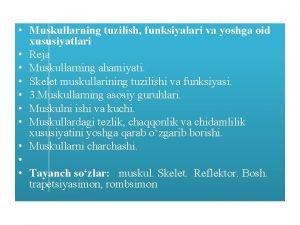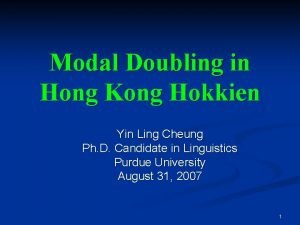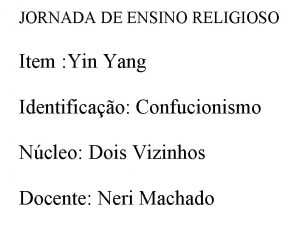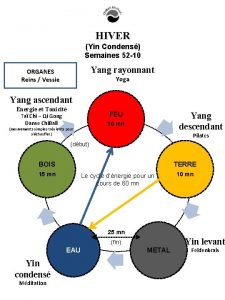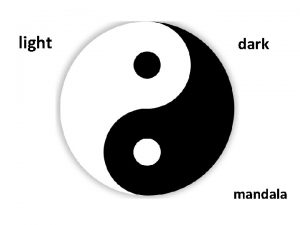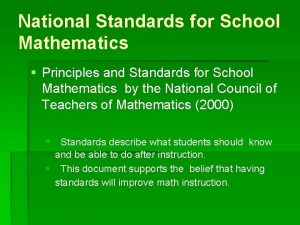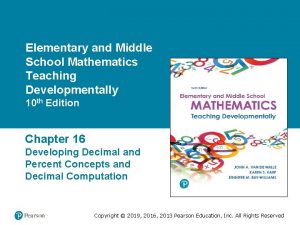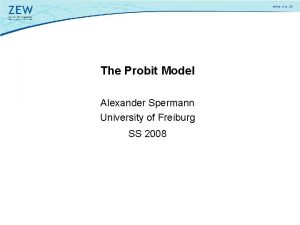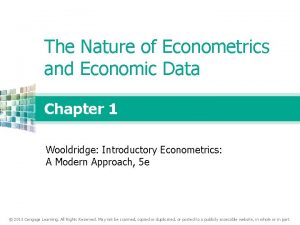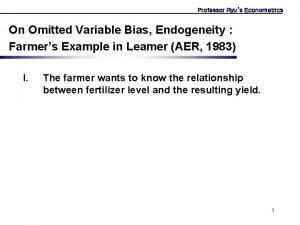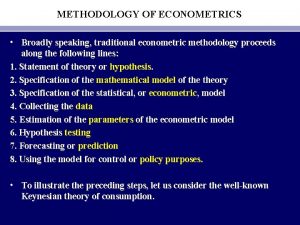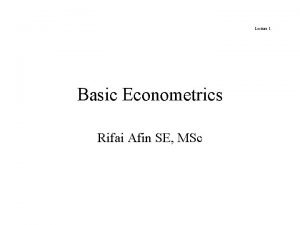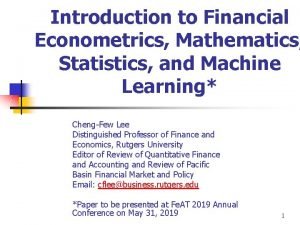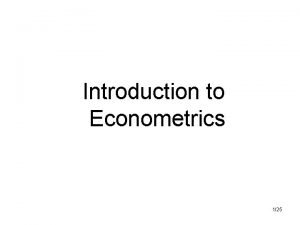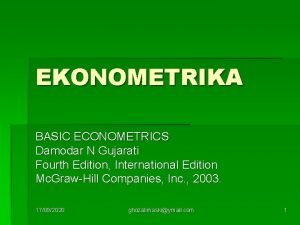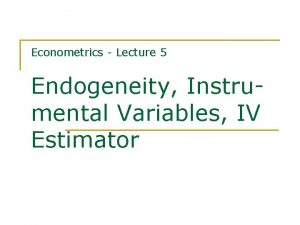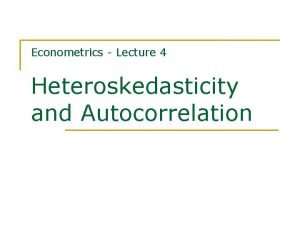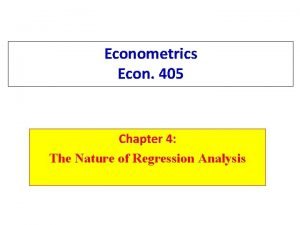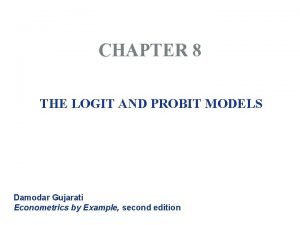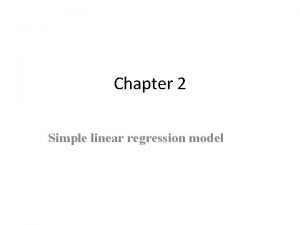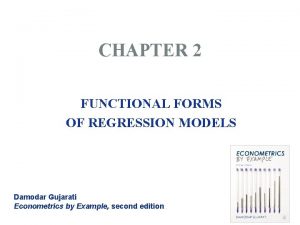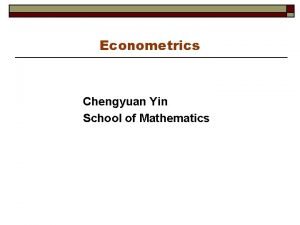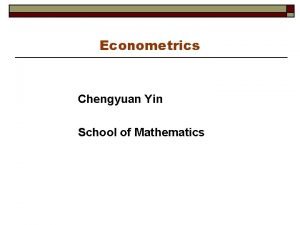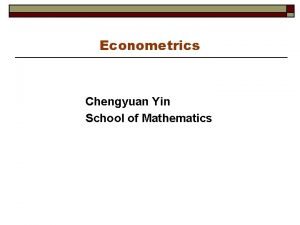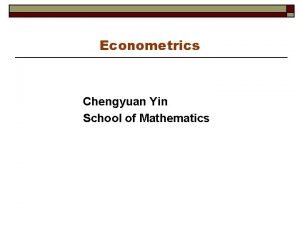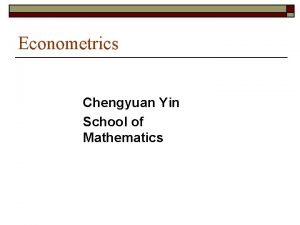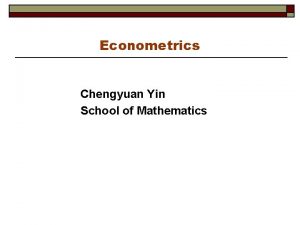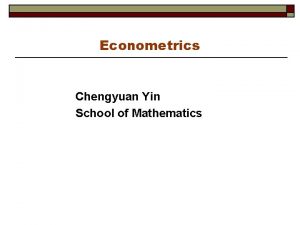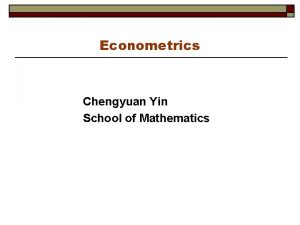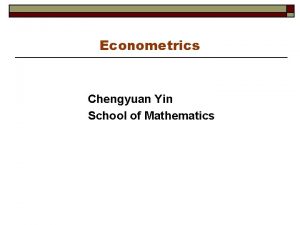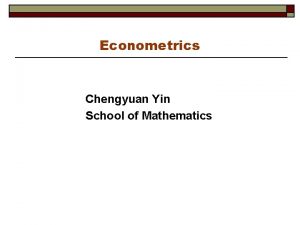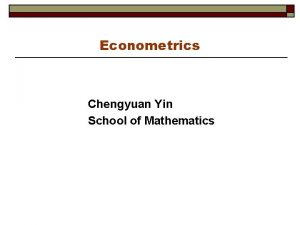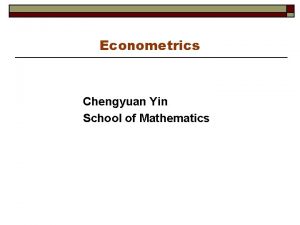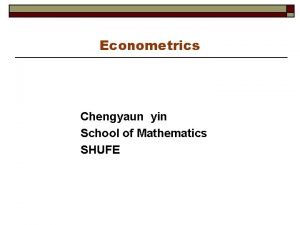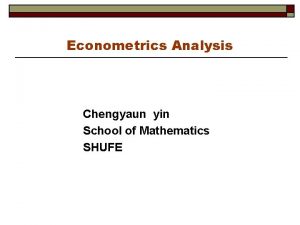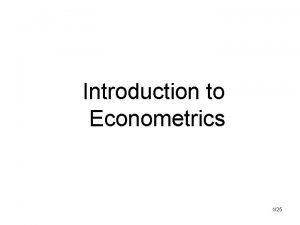Econometrics Chengyuan Yin School of Mathematics Econometrics 22



















































- Slides: 51

Econometrics Chengyuan Yin School of Mathematics

Econometrics 22. The Generalized Method of Moments

The Method of Moments

Estimating a Parameter o Mean of Poisson n n o p(y)=exp(-λ) λy / y! E[y]= λ. plim (1/N)Σiyi = λ. This is the estimator Mean of Exponential n n p(y) = λ exp(- λy) E[y] = 1/ λ. plim (1/N)Σiyi = 1/λ

Normal Distribution

Gamma Distribution

The Linear Regression Model

Instrumental Variables

Maximum Likelihood

Behavioral Application

Identification o o o Can the parameters be estimated? Not a sample ‘property’ Assume an infinite sample n n Is there sufficient information in a sample to reveal consistent estimators of the parameters Can the ‘moment equations’ be solved for the population parameters?

Identification o Exactly Identified Case: K population moment equations in K unknown parameters. n n n o Overidentified Case n n o Our familiar cases, OLS, IV, ML, the MOM estimators Is the counting rule sufficient? What else is needed? Instrumental Variables The Covariance Structures Model Underidentified Case n n Multicollinearity Variance parameter in a probit model

Overidentification

Overidentification

Underidentification o Multicollinearity: The moment equations are linearly dependent. o Insufficient Variation in Observable Quantities P P Q The Data P Q Competing Model A Q Competing Model B Which model is more consistent with the data?

Underidentification – Model/Data

Underidentification - Math

Agenda The Method of Moments. Solving the moment equations Exactly identified cases Overidentified cases Consistency. How do we know the method of moments is consistent? Asymptotic covariance matrix. Consistent vs. Efficient estimation A weighting matrix The minimum distance estimator What is the efficient weighting matrix? Estimating the weighting matrix. The Generalized method of moments estimator - how it is computed. Computing the appropriate asymptotic covariance matrix

Inference Testing hypotheses about the parameters: Wald test A counterpart to the likelihood ratio test Testing the overidentifying restrictions

The Method of Moments Moment Equation: Defines a sample statistic that mimics a population expectation: The population expectation – orthogonality condition: E[ mi ( ) ] = 0. Subscript i indicates it depends on data vector indexed by 'i' (or 't' for a time series setting)

The Method of Moments - Example

Application

Method of Moments Solution create calc sample mini ; ; ; y 1=y ; y 2=log(y)$ m 1=xbr(y 1) ; ms=xbr(ys)$ 1 $ start = 2. 0, . 06 ; labels = p, l fcn= (l*m 1 -p)^2 + (m 2 - psi(p)+log(l)) ^2 $ +-----------------------+ | User Defined Optimization | | Dependent variable Function | | Number of observations 1 | | Iterations completed 6 | | Log likelihood function. 5062979 E-13 | +-----------------------+ +--------------+ |Variable | Coefficient | +--------------+ P 2. 41060361 L. 07707026

Nonlinear Instrumental Variables There are K parameters, yi = f(xi, ) + i. There exists a set of K instrumental variables, zi such that E[zi i] = 0. The sample counterpart is the moment equation (1/n) i zi i = (1/n) i zi [yi - f(xi, )] = (1/n) i mi ( ) = 0. The method of moments estimator is the solution to the moment equation(s). (How the solution is obtained is not always obvious, and varies from problem to problem. )

The MOM Solution

MOM Solution

Variance of the Method of Moments Estimator

Example 1: Gamma Distribution

Example 2: Nonlinear Least Squares

Variance of the Moments

Properties of the MOM Estimator o Consistent? n n o o The LLN implies that the moments are consistent estimators of their population counterparts (zero) Use the Slutsky theorem to assert consistency of the functions of the moments Asymptotically normal? The moments are sample means. Invoke a central limit theorem. Efficient? Not necessarily n n Sometimes yes. (Gamma example) Perhaps not. Depends on the model and the available information (and how much of it is used).

Generalizing the Method of Moments Estimator o o More moments than parameters – the overidentified case Example: Instrumental variable case, M > K instruments

Two Stage Least Squares How to use an “excess” of instrumental variables (1) X is K variables. Some (at least one) of the K variables in X are correlated with ε. (2) Z is M > K variables. Some of the variables in Z are also in X, some are not. None of the variables in Z are correlated with ε. (3) Which K variables to use to compute Z’X and Z’y?

Choosing the Instruments o o Choose K randomly? Choose the included Xs and the remainder randomly? Use all of them? How? A theorem: (Brundy and Jorgenson, ca. 1972) There is a most efficient way to construct the IV estimator from this subset: n n o (1) For each column (variable) in X, compute the predictions of that variable using all the columns of Z. (2) Linearly regress y on these K predictions. This is two stage least squares

2 SLS Algebra

Method of Moments Estimation

FOC for MOM

Computing the Estimator o o o Programming Program No all purpose solution Nonlinear optimization problem – solution varies from setting to setting.

Asymptotic Covariance Matrix

More Efficient Estimation

Minimum Distance Estimation

MDE Estimation: Application

Least Squares

Generalized Least Squares

Minimum Distance Estimation

Optimal Weighting Matrix

GMM Estimation

GMM Estimation

A Practical Problem

Testing Hypotheses

Application: Dynamic Panel Data Model
 Yin yang marketing
Yin yang marketing Chi-yin chow
Chi-yin chow Yin characteristics
Yin characteristics Reja turlari
Reja turlari Anatatsiya nima
Anatatsiya nima Meridianos yin
Meridianos yin Yin e yang masculino e feminino
Yin e yang masculino e feminino Yin energy characteristics
Yin energy characteristics Yin tat lee
Yin tat lee Yin yang fish dish
Yin yang fish dish Alexander yin
Alexander yin Slidetodoc.com
Slidetodoc.com Wenyan yin
Wenyan yin Building theories from case study research
Building theories from case study research How to conclude a case study
How to conclude a case study Taosmo
Taosmo Hui yin
Hui yin Yin
Yin Pnmath
Pnmath Nanna gillberg
Nanna gillberg Yin
Yin Tao religioso
Tao religioso When was new zealand discovered
When was new zealand discovered Eng kuchli muskul
Eng kuchli muskul Cheung yin ling
Cheung yin ling Yin yang significa
Yin yang significa Yin deficiency
Yin deficiency Méridien vessie
Méridien vessie Dark mandala
Dark mandala Yin-wong cheung
Yin-wong cheung Principles and standards for school mathematics
Principles and standards for school mathematics Elementary and middle school mathematics 10th edition
Elementary and middle school mathematics 10th edition Probit model
Probit model Nature of econometrics
Nature of econometrics Confidence interval econometrics
Confidence interval econometrics Endogeneity econometrics
Endogeneity econometrics Mse econometrics
Mse econometrics Gujarati econometrics
Gujarati econometrics Methodology of econometrics
Methodology of econometrics Scope and nature of managerial economics
Scope and nature of managerial economics Methodology of econometrics
Methodology of econometrics Importance of statistics in finance
Importance of statistics in finance Methodology of econometric analysis
Methodology of econometric analysis Basic econometrics damodar gujarati
Basic econometrics damodar gujarati Machine learning econometrics
Machine learning econometrics Endogeneity econometrics
Endogeneity econometrics Autocorrelation in econometrics
Autocorrelation in econometrics Prf in econometrics
Prf in econometrics Qualitative response regression models ppt
Qualitative response regression models ppt Autocorrelation ppt gujarati
Autocorrelation ppt gujarati Srf in econometrics
Srf in econometrics Reciprocal model in econometrics
Reciprocal model in econometrics

